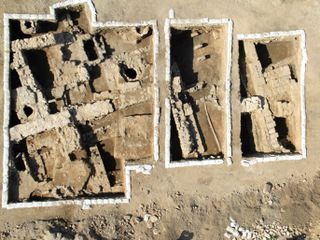In an archaeological excavation the Israel Antiquities Authority conducted c. 100 m west of Tel Akko – next to the Azrieli Shopping Mall compound under construction there – a 1,500 year old public building was discovered that may have been used as a church. The salvage excavation was carried out there as a result of work that had not been coordinated with the IAA and which caused damage to ancient remains located in a declared antiquities site.

According to Nurit Feig, director of the excavation on behalf of the Israel Antiquities Authority, "Until now, the city was known from Christian sources which mention its bishop who took part in formulating the new religion. Now, the first tangible evidence is emerging in the field. This is an important discovery for the study of Akko because until now no remains dating to the Byzantine period have been found, save those of a residential quarter situated near the sea”. A large ashlar-built public edifice was uncovered in the IAA excavation. The size of the building, the impressive construction, as well as the finds – an abundance of roof tiles, parts of marble ornamentations, the pottery and coins – all point to a public structure (possibly a church) that served the Bishop of Akko’s city in the Byzantine period. Terra cotta pipes survived below the wall levels and mosaic pavements adorned the floor in one of its rooms. The building’s inhabitants had a readily available supply of water from a well that was situated in one of the courtyards of the building.
The early Christian sources mention the bishops of Akko and Caesarea who participated in major international conferences and meetings that dealt with formulating religious doctrine, thus attesting to the centrality of Akko for the Christian religion in this period. In addition, we also have evidence of an anonymous pilgrim from the city of Piacenza in Italy, regarding the richness and splendor of the city in the year 570 CE, in which he mentions the beautiful churches within its precincts.
The paucity of Byzantine remains that have been found so far can be attributed to the destruction caused by those who came thereafter. In addition, earlier structures that date to the Hellenistic period were exposed beneath the foundations of the Byzantine public building. Their contents were rich and diverse and included imported pottery vessels from the Mediterranean basin, among them amphorae from the Isle of Rhodes, as indicated by the handles that bear the governors’ names.
Ω
No comments:
Post a Comment